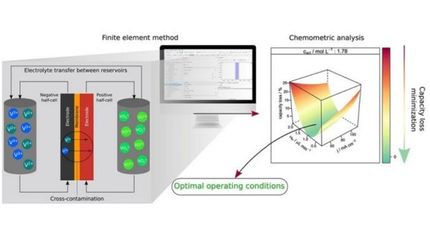Batteries: Modeling tomorrow's materials today
Microstructure simulations reveal strong influence of elastic deformations on charging behavior of layered oxides as cathode in sodium-ion batteries
What factors determine how quickly a battery can be charged? Researchers at the Karlsruhe Institute of Technology (KIT) are investigating this and other questions using computer-aided simulations. Microstructure models are helping to discover and investigate new electrode materials. For sodium-nickel-manganese oxide as a cathode material in sodium-ion batteries, the simulations show changes in the crystal structure during the charging process. These lead to elastic deformation, which causes the capacity to shrink. The researchers report in the journal npj Computational Materials.
Research into new battery materials is not only aimed at optimizing performance and service life and reducing costs. Rather, it is also about reducing rare elements such as lithium and cobalt as well as toxic components. Sodium-ion batteries, which are based on similar principles to lithium-ion batteries but can be produced from raw materials that are sufficiently available in Europe, are considered promising. They are suitable for stationary and mobile applications. "Layered oxides such as sodium-nickel-manganese oxides are promising materials for the cathode," reports Dr. Simon Daubner, group leader at the Institute of Applied Materials - Microstructure Modelling and Simulation (IAM-MMS) at KIT and corresponding author of the study. He is researching sodium-ion technology in the Cluster of Excellence POLiS (which stands for: Post Lithium Storage).
Mechanical stresses occur during fast charging
However, there is a problem with these cathode materials: sodium nickel manganese oxides change their crystal structure depending on how much sodium is currently stored. If the material is charged slowly, everything happens in an orderly fashion. "Layer by layer, the sodium leaves the material - like a parking garage that empties floor by floor," explains Daubner. "But when things need to move quickly, the sodium is pulled out from all sides." This causes mechanical stresses that can permanently damage the material.
Researchers at the Institute of Nanotechnology (INT) and the IAM-MMS at KIT, together with scientists at the University of Ulm and the Center for Solar Energy and Hydrogen Research Baden-Württemberg (ZSW), have now uncovered these relationships with the help of simulations and report on them in npj Computational Materials, a journal from the Nature portfolio.
Experiments confirm simulation results
"Computer models can describe different length scales, from the arrangement of atoms in electrode materials and their microstructure to the cell as the functional unit of each battery," says Daubner. They combine microstructure models with slow charge and discharge experiments to investigate the layered oxide NaXNi1/3Mn2/3O2. The material exhibits several degradation mechanisms that lead to a loss of capacity. It is therefore not yet suitable for commercial applications. When the crystal structure changes, elastic deformation occurs. The crystal shrinks, which can lead to cracks and reduce the available capacity. As simulations carried out at INT and IAM-MMS have shown, this mechanical influence is so strong that it has a significant impact on how quickly the material can be charged. Experimental investigations at the ZSW confirmed the results.
Some of the findings from the study can be transferred to other layered oxides. "Now that we understand the fundamental processes, we can devote further work to developing battery materials that are durable and can be charged as quickly as possible," summarizes Daubner. This could make the widespread use of sodium-ion batteries a reality in five to ten years.
Note: This article has been translated using a computer system without human intervention. LUMITOS offers these automatic translations to present a wider range of current news. Since this article has been translated with automatic translation, it is possible that it contains errors in vocabulary, syntax or grammar. The original article in German can be found here.
Original publication
Simon Daubner, Manuel Dillenz, Lukas Fridolin Pfeiffer, Cornelius Gauckler, Maxim Rosin, Nora Burgard, Jan Martin, Peter Axmann, Mohsen Sotoudeh, Axel Groß, Daniel Schneider, Britta Nestler; "Combined study of phase transitions in the P2-type NaXNi1/3Mn2/3O2 cathode material: experimental, ab-initio and multiphase-field results"; npj Computational Materials, Volume 10, 2024-4-18
Other news from the department science
Most read news
More news from our other portals
See the theme worlds for related content
Topic World Battery Technology
The topic world Battery Technology combines relevant knowledge in a unique way. Here you will find everything about suppliers and their products, webinars, white papers, catalogs and brochures.

Topic World Battery Technology
The topic world Battery Technology combines relevant knowledge in a unique way. Here you will find everything about suppliers and their products, webinars, white papers, catalogs and brochures.































































